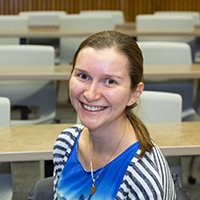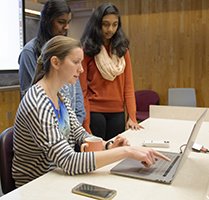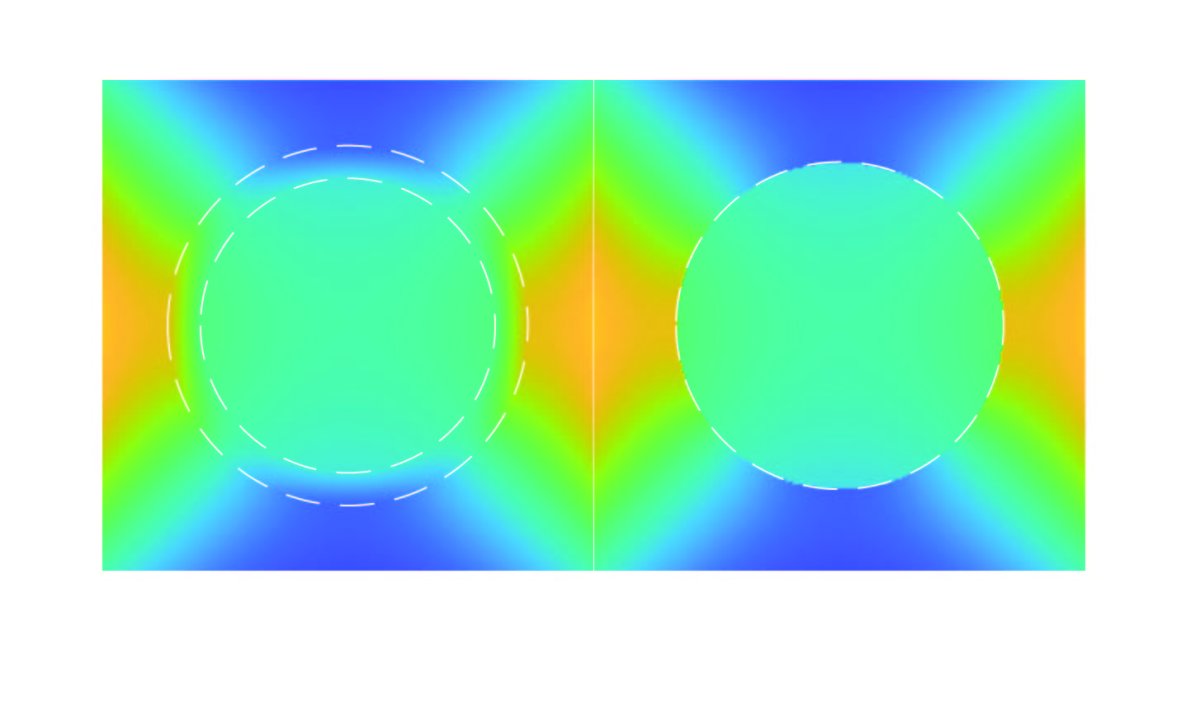Student Profile: Svetlana Baranova

Svetlana Baranova’s heart is drawn to research and applied mathematics
SVETLANA BARANOVA loves to solve problems; more precisely, she loves to apply mathematics to solve complex modeling problems.
“I was always quite interested in mathematics. I was always happy to solve equations, to find a good—or a better way to solve problems using mathematics.”
Baranova grew up in a small city in Siberia. There she had good teachers, and eventually, she went on to the Novosibirsk State University, which has one of the best physics programs in Russia. “I loved being at the university. I felt I could smell science in the air! My time there was wonderful and very influential in my wanting to be part of solving problems or doing research. My heart is drawn to this technical part of research! My interest is not in a specific area of application, but in the process of solving mathematical problems.”
After completing her Master’s degree in physics, Baranova left Novosibirsk to work with Schlumberger, the largest gas and oil service company in the world. She worked as a field engineer in Siberia, above the polar circle. Baranova says, “When given a choice, I chose the most challenging and the most exciting location to work. I once saw the aurora borealis, right above our field. Yet, after two years, I felt a desire to do more research.”
As one might expect of a researcher, Baranova diligently sought out academic opportunities. She found a research home in the geomechanics group in the Department of Civil, Environmental, and Geo- Engineering at the University of Minnesota.
“I talked with my contacts through the university, and through that network, I connected with Professor Bojan Guzina and came to the University of Minnesota. In the first year, I took a class on the boundary element method with Professor Sonia Mogilevskaya. That class gave me a feeling similar to what I experienced at Novosibirsk, precisely deriving rigorous equations. I began working with Professor Mogilevskaya on an additional project, which was quite interesting and involved challenging math. Eventually, I shifted to her research group.”
Baranova was able to attend the Isaac Newton Institute for Mathematical Sciences (INI) in Cambridge, England, where she participated in a workshop on computational complex analysis. “It was wonderful to sit and talk with such brilliant people about smart ways to solve difficult problems,” remembers Baranova. “It was very inspiring.”
This summer, Baranova was selected to participate in the Association of Women in Mathematics (AWM) Workshop on Mathematics of Materials held as part of the Second Joint Society for Industrial and Applied Mathematics (SIAM) and The Canadian Applied and Industrial Mathematics Society (CAIMS) Annual Meeting. Because of the pandemic, the conference moved to an online format. Although the online format somewhat limited her ability to talk with as many people as she would have liked, Baranova was able to present her research to an international audience.
Her research has not been impacted by the pandemic-fueled move to digital life. “In this sense, I am very lucky. Paper, a pen, and my laptop, that is all I need to do my research. Some researchers were struggling to get back into their labs, but I was able to continue my research uninterrupted.”
Baranova also considers herself lucky to have landed in the geomechanics group within CEGE. “We are a group of about ten students, including international students from many countries. We have offices together on the 7th floor of the Civil Engineering Building. Everyone is so kind and positive. Our meetings are always pleasant. We celebrate one another’s birthdays together—dinner in a café or a picnic in Stillwater, Minnesota (a short drive from the Twin Cities). We are like family. I can truly rely on these people, and I support them, as well. I truly enjoy being part of this group.”
Baranova shares her experience as an international student. “We are likely overworked and a little stressed, but it is just a part of the process. I think it comes down to the relationship between an adviser and advisee. If you are comfortable with your adviser, the work is not so heavy emotionally. With support from your adviser, you can feel motivated and be ready to stay late on weekdays and work on the weekends. However, if the relationship is not so good, you feel more tension and stress that could cause a lack in motivation and productivity. In my situation, I have been very lucky to work with Prof. Mogilevskaya; she has always supported me in my educational journey.”
Research is not Baranova’s only involvement. She was the head of the Graduate Student Board in CEGE, which involved planning scholarly and social activities, and working to ensure a positive environment for graduate students in the department. The last two years, Baranova has been the Graduate Women Coordinator for CEGE, working at both the departmental and college level. Starting in the fall semester, Baranova expanded her role, serving as the newly created CEGE Graduate Diversity Coordinator, reaching out to various communities within CEGE graduate programs to foster recruitment, retention, and success for all.

One of Baranova’s most rewarding activities has been mentoring two middle school students with a passion for math. Abirami Rajasekaran and Harini Senthilkumar first contacted Prof. Mogilevskaya about additional tutoring after they had completed all opportunities in their school. Baranova taught them to use MATLAB, and with that tool in their hands, they started investigating data on Minnesota lakes. Mogilevskaya and Baranova mentored them in this research.
Using the skills they developed with MATLAB, the girls completed a research project that they submitted to various science competitions. Their project, “A computational analysis of the effects of Dreissena polymorpha on the ecological integrity of Minnesota lakes,” has brought them much acclaim. The young researchers competed at the Twin Cities Regional Science Fair 2020 in February and were chosen as alternates for the ISEF (International Science and Engineering Fair). They participated in the State Science and Engineering Fair (online this year) where they won the Silver award, which is given to the top 10% of the participants. The young researchers won the Minnesota Section for the Stockholm Junior Water Prize. The judges wrote, “…against a number of other very strong projects, … your project really stood out from the rest! … It was … thoughtful and had an especially strong presentation …Great work!” The girls prepared a public education video for Stockholm Junior Water Prize National Competition and received 2nd place.
Exploring the problem of thin interphase layers
Svetlana Baranova gives a brief explanation of her research.
Thin layers could be found in a variety of engineering applications to prevent damage and increase durability of structures and products, or to enhance specific material properties. Despite recent progress, performing experiments on the micro and nano scales remains a difficult task. Thus, the need to develop new theoretical methods and computational tools for analysis is well recognized.
Modeling of materials with thin layers is challenging. Existing computational tools can be time-consuming or computationally expensive, or, in some cases, they are not applicable. To bypass that, an alternative approach proposes to simulate the presence of a layer by a zero-thickness interface with properly designed conditions for the jumps of relevant physical fields (for example, temperature, displacements, or stresses) across the interface.
My doctoral research consists in developing a new methodology to derive imperfect interface models for the problems of conductivity or linear elasticity with interphase layers. The methodology combines classical asymptotic analysis with concepts from the theory of complex-valued functions. The theoretical discoveries from this research could help to unlock the potential of predictive simulations to design new materials with thin coatings and optimize their properties.
